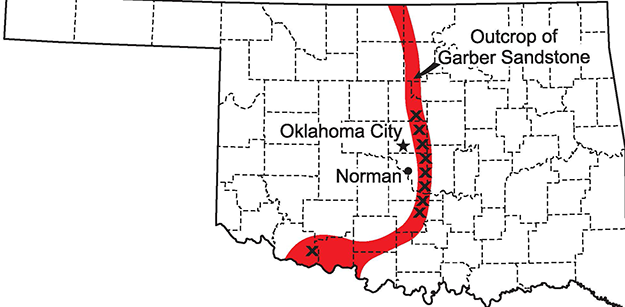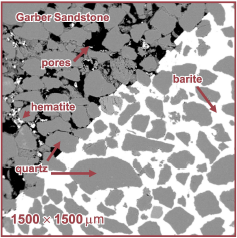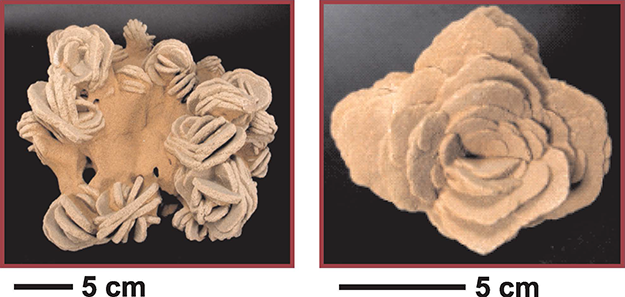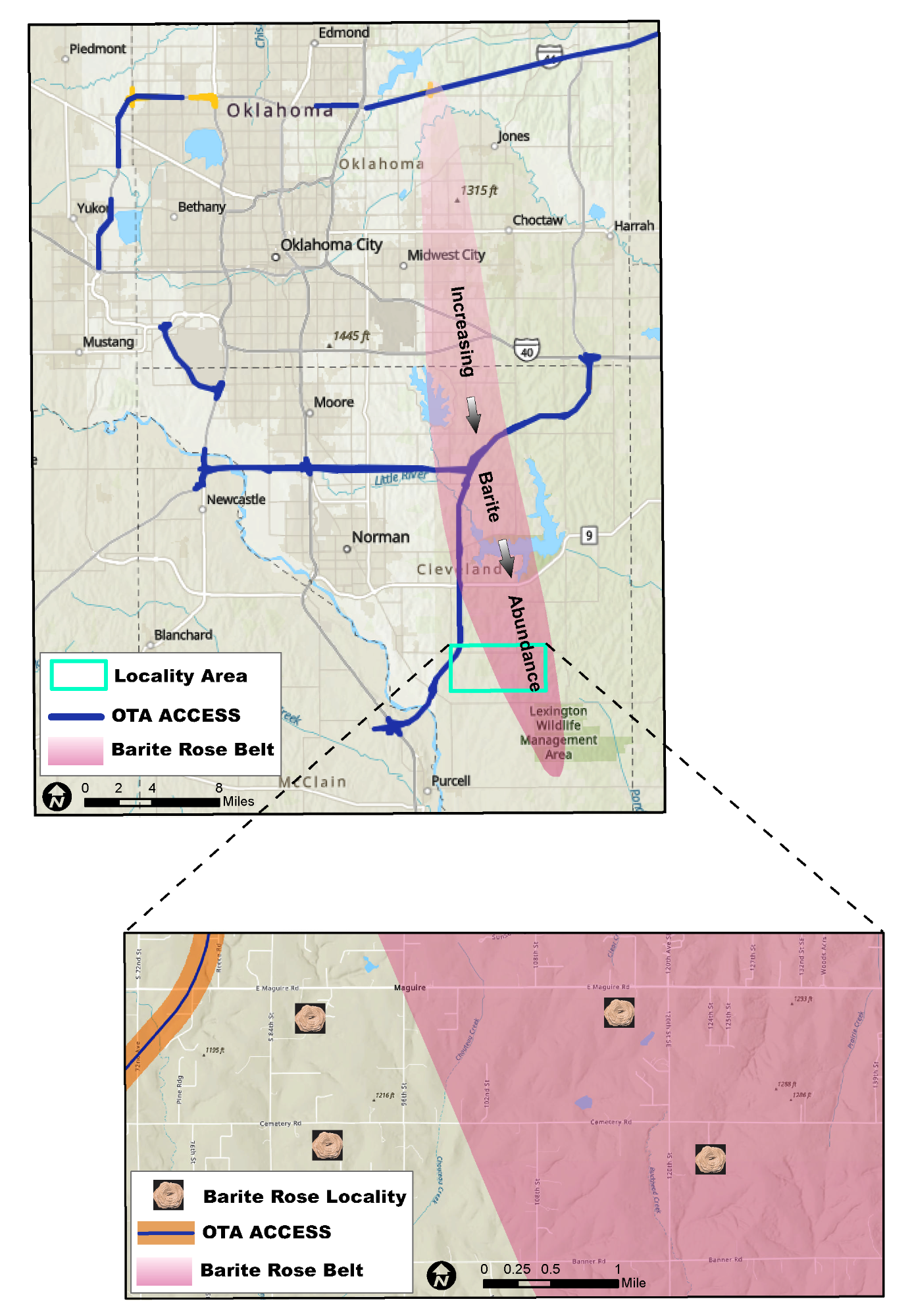Few mineral specimens are as distinctly recognizable and traceable to source as the barite roses from Oklahoma. These are also known as "rose rocks" and "barite-sand rosettes." Other than minor occurrences in Kansas, Morocco, and Australia, the barite roses are unique to this state.
Rose Rocks
The State Rock of Oklahoma

Rose Rock

History and Lore
The barite rose became the official state rock of Oklahoma when Oklahoma House Bill 1277 was signed into law in 1968. Noble, Oklahoma, was made the official rose rock capital (of Oklahoma, and by default, the world) via an "emergency" act of the Oklahoma House of Representatives in 1983.
A myth attributed to the Cherokees holds that the barite roses formed from the tears of their women and the blood of their men who were removed to Oklahoma from Georgia, 1838-39. Representatives of the Cherokee Nation disavow this legend, noting that barite roses do not occur on any of the lands granted to the Cherokees.
Geology
The barite roses consist of radial and rosette sprays of disc-shaped barite crystals (BaS04} that contain angular medium quartz sand (Si02) derived from the geologic formation called the Garber Sandstone. A small quantity of hematite (Fe203) imparts a reddish color to the roses.
Geology

Rose Rock Electron Micrograph
The barite roses consist of radial and rosette sprays of disc-shaped barite crystals (BaS04} that contain angular medium quartz sand (Si02) derived from the geologic formation called the Garber Sandstone. A small quantity of hematite (Fe203) imparts a reddish color to the roses.
An electron micrograph (shown on left) shows the boundary between a barite rose and the enclosing Garber Sandstone.
The roses formed when barite crystals precipitated from groundwater in the pore spaces between quartz sand grains within the Garber Sandstone. The roses reflect the shapes of the barite crystals, and hence they are cataloged as minerals.

Largest Rose Rock
Most barite roses range from 1 to 10 cm in diameter, though these coalesce into clusters weighing hundreds of kg.
The largest known single rose measures 51x56x53 cm and weighs 135 kg.
How Old Are They?
The barite roses were deposited in fractures and along porous horizons within the Garber Sandstone some time after it was lithified (turned to rock). The exact age is not known, and roses could still be growing today.
Why Only In Oklahoma?
Red Permian sandstones like the Garber (-250 million years old) are common throughout the world, yet barite roses are extremely rare. The origin of the roses, therefore, does not result from the depositional environment of the sandstone, but stems from some other uncommon feature of Oklahoma's geology.

How Do They Get Their Shape?
Each "petal" of a rose is a single crystal of barite, and what makes these barite crystals unusual is their round, disc-like shape. The best explanation to date is that the barite grew in the presence of organic compounds that stunted growth at the corners of crystals, leading to the rounded shape.
How Do They Form?
At present, the best explanation for the roses is that deep basinal groundwater containing barium and reduced sulfur species (sulfide) migrated upward along fractures and porous layers into the Garber Sandstone. Upon reaching an aerated region, the sulfur in the groundwater was then oxidized from sulfide to sulfate, leading to the precipitation of barite (which is extremely insoluble in natural waters). Another possibility is that separate sources of barium- and of sulfate-rich waters mixed during flow through the permeable Garber Sandstone, and hence barite roses were deposited where these two solutions mixed.

OGS Publications on Rose Rocks
Additional Information
Acknowledgments
Rose rock information and photos provided by Dr. David London.
Barite Rose Rocks and the Planned Oklahoma Turnpike Authority ACCESS extension
The Oklahoma Geological Survey (OGS) is chartered in the Oklahoma Constitution with investigating the state's land, water, mineral, and energy resources, and disseminating the results of those investigations to promote the wise use of Oklahoma's natural resources consistent with sound environmental practices. We offer numerous ways to learn about the Oklahoma’s geology through our web portal, general email and phone lines, and open-house days now offered approximately every month. Because of our status as one of the Secretary of Energy and Environment’s agencies, we routinely are consulted about projects and activities throughout the state. We do our best to always respond to these with clear directions toward non-commercial resources, and occasionally commit our own resources – funded by the taxpayers of Oklahoma - to investigating special topics.
Recently, we have had several inquiries from citizens about the Oklahoma Turnpike Authority’s ACCESS extension’s possible impact on a geological feature, the rose rocks. Rose rocks are flower-shaped collectible pieces of barium-sulfate (the element barium, Ba, bonded with oxidized sulfur, S, and four oxygens, making BaSO4). The red color of the rose rock stems from some amount of iron in the material. Most ornamental rocks and minerals like rose rocks are collected from vugs (holes) in volcanic material or fractures in bedrock. Instead, rose rocks are collected directly from the rock that makes up roadsides, driveways, and the few outcroppings of bedrock in the area between an area just northeast of the town of Lexington, across the eastern edge of Norman, to just north of Stanley Draper Lake (see the attached map, below). University of Oklahoma Professor David London (now retired) spent considerable time studying the rose rocks, as published in a journal called the “Mineralogical Record” and reprinted with permission in OGS Information Series 113 (available at no cost from our website). To our knowledge, no scientist has completely understood what controls the distribution of rose rocks, or how exactly they form, but we have some sense of their distribution in Oklahoma and worldwide. Indeed, they are relatively uncommon worldwide, and in Oklahoma limited to this area, consistent with their designation as “the State Rock of Oklahoma”, signed into state law in House Bill 1277 in 1968.
In response to citizen concern, OGS recently visited the area on the east edge of Norman between approximately 72nd and 120th Ave SE, in the vicinity of Maguire Rd. The locations for historic rose rock collecting remain closed and on private property, though city streets and private driveways and yards have yielded recent rose rock collection opportunities. In the figure below, we depict the approximate location of the planned ACCESS highway extension in relation to this area, and in relation to the eastern edge of the extent of rose rocks as depicted in David London’s 2008 article. The OGS makes no further assessment of the impact of the planned road construction on the preservation of rose rocks.
We have also been asked by concerned citizens to comment on the concept of “geoheritage”. OGS views this request as also within our mandate because OGS is engaged in connecting the public to their environment through appreciation of remarkable geological features. Geoheritage is an area of active discussion between many groups, but notably between the US National Park Service, the US Geological Survey, the American Geological Institute, and the Geological Society of America, the first two federal agencies and the latter two non-profit, science societies. Also of interest is the United Nations Educational, Scientific, and Cultural Organization (UNESCO). In response to citizen concern, we (the OGS) have updated our website to provide recommended links (see below) to the appropriate resources to understand how these agencies, non-profit societies, and global classifications and registries serve the public on conservation and education efforts.
Recommended links:
National Park Service
Geological Society of America
American Geosciences Institute


